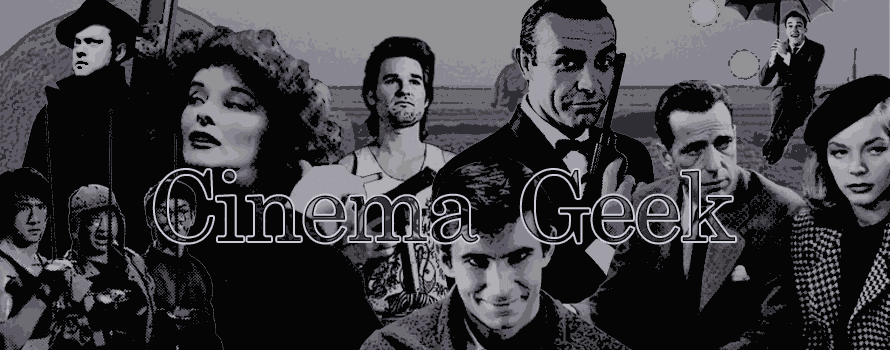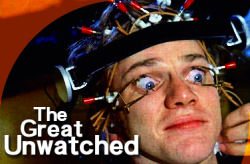This piece was originally written to help sort out some confusion friends were having about anamorphic DVDs and aspect ratios. I thought it'd be cool to throw it here as well.
The world of aspect ratios in movies can be really confusing. Why are
some movies wider than others? Is widescreen always a good thing?
What's it mean when a DVD is "16x9 enhanced"? Why is it that when I
play my older DVDs on my new widescreen television, they have black
bars on the sides as well as the top and bottom?
1. What IS an Aspect Ratio?
In
simple terms, an aspect ratio is an expression of the relation between
an image's width and its height. There are two ways of expressing them
-- with whole numbers and with decimals.
Media (movies,
television shows) ratios are usually expressed with decimals -- a movie
with an aspect ratio of 1.78:1 will be 1.78 times wider than it is
tall. The higher the first number, the wider the picture.
Marketing text on displays (computer monitors and televisions) will use whole numbers, which are easier for the consumer to digest,
but actually make the math a bit more ridiculous. A television with a
16x9 display (the norm for widescreen sets) is 16 times wider than nine
times its height. Really, 16x9 is just 1.78:1, but in terms that look
good on a weekly electronics flyer.
For the rest of this piece, I'll express the ratio in terms of [decimal]:1 (1.33:1, etc.).
2. A little bit of history
Image 2A
Frame from 1.19:1 movie
Fritz Lang's M (1931)
 Image 2B
Frame from 1.37:1 movie
Cropped to 1.33:1 on DVD
Edgar G. Ulmer's The Black Cat (1934)
Image 2B
Frame from 1.37:1 movie
Cropped to 1.33:1 on DVD
Edgar G. Ulmer's The Black Cat (1934)
In
the silent era, films were presented in 1.33:1 or 4:3 ratio -- roughly
the shape of a non-widescreen television. When sound films came in,
additional space was needed on the film strip for the optical
soundtrack. Initially, this caused movies to be reduced to 1.19:1 (see
Image 2A), which many people found disorienting.
Eventually, a
standard was established which reduced the height of the image to
compensate for the loss of width. Known at the Academy Ratio, 1.37:1 is
how most older films are meant to be viewed. Not that you will -- when films are released to television and DVD, the studios (every last one of them) figure that the difference between the Academy Ratio and the
1.33:1 ratio of standard televisions is so slight that they crop out a small part of the picture.
The screencap provided in Image 2B, therefore, is not a completely
accurate representation of Edgar Ulmer's The Black Cat and it's
certainly not a good representation of the Academy Ratio.
But I digress.
As
television threatened to steal customers from movie theaters, the
studios fought back by moving to more color productions and by adding
another element -- widescreen. There were multiple widescreen
standards. One of the earliest (and widest) was Cinerama, which
involved shooting a movie with three cameras simultaneously, then
projecting it from three carefully placed projectors onto a curved
screen. The aspect ratio was, roughly, 2.65:1.
A more common
practice was to film at Academy ratio and then matte (or block) out
part of the picture when the film is projected. Directors and
cinematographers using this method would usually have guides on the
lens to let them know what was and wasn't part of the composition.
Ratios for this method include 1.66:1 and 1.85:1, with many 1.85:1 films being reformatted to 1.78:1 for DVD (see
Images 2C-2E).


 Images
2C-2E: Various matted aspect ratios. From left to right, Mario Bava's
Black Sunday (1960, 1.66:1), Black Sabbath (1963, originally 1.85:1, reformatted to 1.78:1), and Shock (1977, 1.85:1)
Images
2C-2E: Various matted aspect ratios. From left to right, Mario Bava's
Black Sunday (1960, 1.66:1), Black Sabbath (1963, originally 1.85:1, reformatted to 1.78:1), and Shock (1977, 1.85:1)
However,
making the image any wider reduced the amount of space you used in the
35mm frame drastically, resulting in a loss in quality. The
solution for this was an anamorphic lens, which filled the whole 35mm
frame with the rectangular widescreen image by horizontally compressing
the image. When exhibited, the film would then be uncompressed by
another anamorphic lens on the projector (see Images 2F-2G).

 Images
2F-2G: The anamorphic process. Top image: a still from Mario Bava's
Knives of the Avenger (1966, 2.35:1). Bottom image: The same still altered to
approximate its appearance as a 35mm frame.
Images
2F-2G: The anamorphic process. Top image: a still from Mario Bava's
Knives of the Avenger (1966, 2.35:1). Bottom image: The same still altered to
approximate its appearance as a 35mm frame.
There are other methods and techniques, including using 70mm and Super35mm film, but I've covered the biggies.
3. How this all works on DVD
Like
a 35mm film frame, a standard DVD has limited resolution. In this case,
it's 720x480 pixels (don't do the math there -- the pixels are
non-square. The square pixel resolution actually works out to about
640x480 or 1.33:1).
Early DVDs simply handled widescreen images by slapping black bars on the actual image (Image 3A).
 |
Image 3A. Matted widescreen. From Mario Bava's Hatchet for the Honeymoon (1970, 1.66:1). |
Note
even here, in the least wide of the widescreen formats, there is a loss
of a good 19% of the possible image resolution to black bars. Worse,
because the image itself is 1.33:1, it will appear on a widescreen (16:9)
television as either matted on the sides as well as the top and bottom
or it will be stretched to fill the screen, distorting the picture
horizontally.
Later, anamorphic enhancement was developed. It
follows the same basic principle of anamorphic film -- the image is
squeezed horizontally and then pulled back out. The difference in DVD
terms is that it can be used for any aspect ratio that is as wide as or
wider than 1.78:1. On 4:3 TV, the film will display with black bars
(rendered by the player), while on a widescreen television, a 1.78:1
film will fill every available pixel (higher ratios will have bars on
the top and bottom, but to a much lesser degree).
In cases where
the image is 1.66:1, studios like Warner Bros. will (much to my
consternation) crop the image vertically until it is 1.78:1 (or even
1.85:1), so it will fit on widescreen televisions without needing to
present the film in a "windowbox" (with bars along the left and right sides).
Curse of Frankenstein, I'm looking at you. Other companies
like Criterion Collection will preserve the original aspect ratio. Go
Criterion.
I'm ignoring the whole full-frame/pan'n'scan/standard thing
right now. Anybody who prefers that over widescreen loses 33% of the image and I'm not going to waste more time (than I already have) nagging them about it.
However, there's a weird
flipside to it, which is companies turning films that were originally
exhibited in Academy Ratio into widescreen movies. The most egregious example
of this (mostly because it was done with the filmmaker's blessing but
without any real artistic rationale to back it) is Anchor Bay's special
"Book of the Dead" edition of Sam Raimi's
The Evil Dead. The original
was filmed on 16mm in 1982 and, up until the BotD, had always been
exhibited at 1.37:1. Anchor Bay worked with star/producer Bruce
Campbell to put it into widescreen format (I think because "widescreen"
had become a buzzword at that point). The result is that whole sections
of valuable visual information are completely sliced out of the top and
bottom of the frame. Thankfully, when Anchor Bay came out with their Ultimate Edition of
The Evil Dead, they provided both widescreen and 1.33:1 options.
4. Conclusion
I know what you're asking now. Why are most of Nate's examples from Mario Bava movies?
You're missing the more pertinent question -- just how awesome is Bava? I mean really?

 B-Sol of The Vault of Horror here. Firstly, let me just thank Nate so very much for giving me this outlet to express my love for cinema beyond the realm of the frightening. As he announced some days ago, I've been invited to contribute here at Cinema Geek, and I couldn't be happier about it.
B-Sol of The Vault of Horror here. Firstly, let me just thank Nate so very much for giving me this outlet to express my love for cinema beyond the realm of the frightening. As he announced some days ago, I've been invited to contribute here at Cinema Geek, and I couldn't be happier about it. The series of posts to which he referred is something I like to call, "52
The series of posts to which he referred is something I like to call, "52  Perfect Movies". I've been planning it for some time now--the trials and tribulations of daily life in the real world have kept me a bit too occupied as of late, but I just wanted to let everyone know that it is coming.
Perfect Movies". I've been planning it for some time now--the trials and tribulations of daily life in the real world have kept me a bit too occupied as of late, but I just wanted to let everyone know that it is coming. Once a week (in a perfect world), I will be spotlighting a different film. Each of them is a film that, in my humble opinion, can be said with relative certainty to be
Once a week (in a perfect world), I will be spotlighting a different film. Each of them is a film that, in my humble opinion, can be said with relative certainty to be  completely flawless. They are examples of the absolute pinnacle of movie-making, as I see it. I freely admit this is an entirely subjective endeavor, but I sincerely hope you will enjoy it nevertheless.
completely flawless. They are examples of the absolute pinnacle of movie-making, as I see it. I freely admit this is an entirely subjective endeavor, but I sincerely hope you will enjoy it nevertheless. As for the movies themselves, I'm in a generous mood, so I'v
As for the movies themselves, I'm in a generous mood, so I'v e included a few pictures to give you an idea of what some of them will be. I'll be doing it in chronological order, and hope to start things up very soon. So stay tuned, and here's to a year's worth of perfect movies...
e included a few pictures to give you an idea of what some of them will be. I'll be doing it in chronological order, and hope to start things up very soon. So stay tuned, and here's to a year's worth of perfect movies...











